#long hoverfly
Explore tagged Tumblr posts
Text


just two common flower flies: Episyrphus balteatus and Sphaerophoria scripta
#marmalade hoverfly#syrphini#long hoverfly#sphaerophoria#syrphids#syrphidae#bugblr#poland#insectblr#hajovyk bug
2 notes
·
View notes
Text
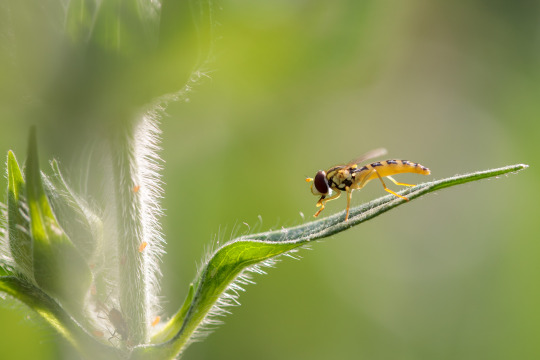
Long Hoverfly
A long hoverfly resting on a sunlit leaf, in the garden.
#30dayswild#canon#canonuk#fauna#garden#hoverflies#hoverfly#insect#insects#invertebrate#invertebrates#long hoverfly#minibeast#minibeasts#nature#outdoors#sphaerophoria scripta#spring#springwatch#wildlife
15 notes
·
View notes
Text
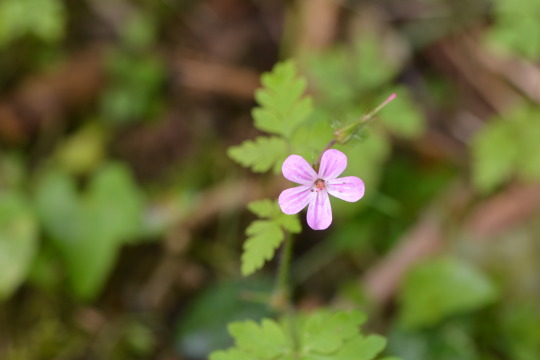

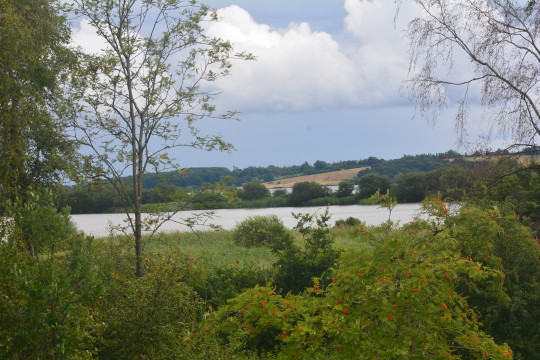
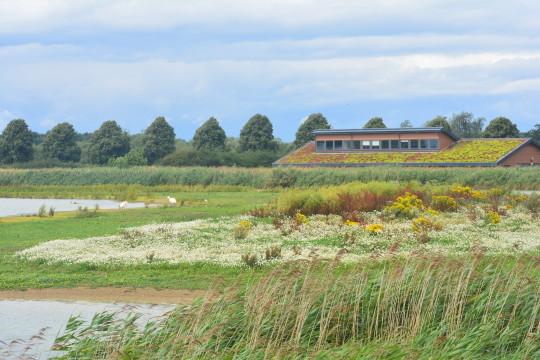
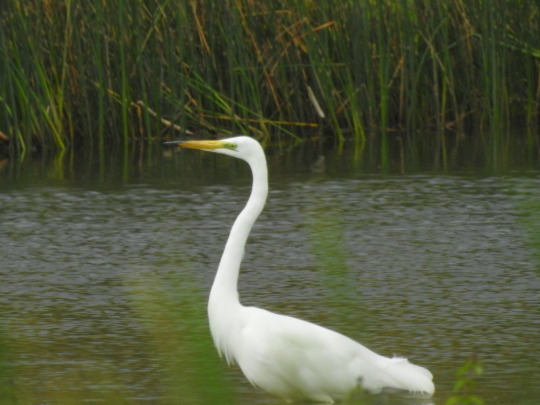
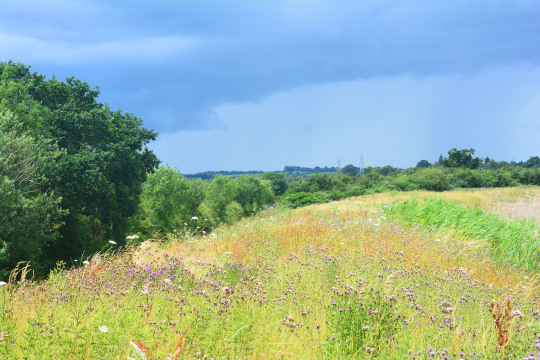
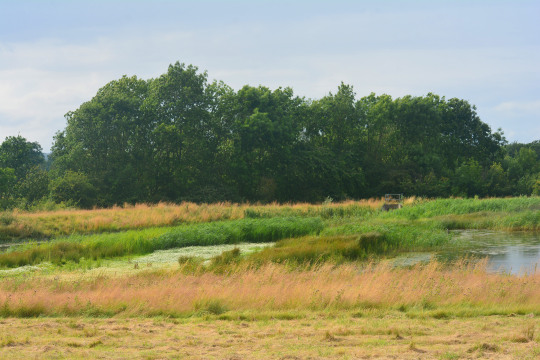


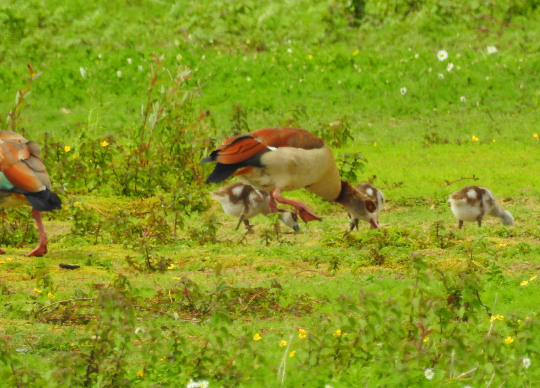
16th July 2023: Egleton, Rutland Water
Photos taken in this set: 1. Herb-Robert. 2, 3, 4, 6 and 7. Views at this beautiful reserve. 5. Great White Egret, a star bird again this weekend. I still find it quite surreal when we have a run of visiting good habitats for them and they're so commonplace, being a bird that was a real rarity when I first got into birdwatching. They're great to watch too with their larger than life stature and quirky movements. 8. Green Sandpiper, a key bird that we wanted to see at the nature reserves whilst away and it was an honour to see loads of them on lagaoon four. They are such beautiful birds and I really just enjoyed watching them and taking them in. 9. Comma, one of a few wonderful butterflies I enjoyed seeing especially in a blooming patch of meadow. 10. Egyptian Geese, another key Rutland bird, with adorable goslings. The gosling I saw of one at Petersfield Heath Pond earlier in the month was the first Egyptian gosling I'd seen I think but was bigger so it was lovely seeing these little goslings.
Another year tick in Yellow-legged Gull seen nicely with Herring and Lesser Black-backed Gulls for comparison and some chicks of the latter in an Osprey nesting platform were other key birds seen, as well as stunning views of Osprey and Hobby acrobatically working through the air seeing both successfully hunt. Birds I adore seen so well this weekend. Sand Martin, Little Egret, Great Crested and Little Grebe, Shelduck, Blackcap seen extremely well, Reed Warbler, delightful Teal, Gadwall, Lapwing, Oystercatcher, Common Sandpiper, Common Tern, Swift, Goldfinch, Pied Wagtail and Linnet chasing each other and Stock Dove were other key birds seen. It was an insect fest with Painted Lady, Red Admirals, Gatekeeper, Ringlet, Meadow Brown, Brimstone, Small Tortoiseshell seen well at the visitor centre, Small Skipper, Green-veined White, Small White and Speckled Wood butterflies, Southern Hawker, Common Darter, Brown Hawker and Black-tailed Skimmer dragonflies, Common Red Soldier beetle, ladybird, Bird-cherry Ermine moth and Marmalade and Long hoverflies other standout insects seen. Poppy, fox-and-cubs, bird vetch, wild carrot, lady's bedstraw, field scabious, self-heal, viper's-bugloss, red campion, white deadnettle, white and broad-leaved clover, thistle, great willowherb, ragwort, forget-me-not, burdock and meadowsweet were other key plants seen.
#meadowsweet#photography#birdwatching#lady's bedstraw#painted lady#yellow-legged gull#green sandpiper#white deadnettle#england#uk#world#nature#viper's-bugloss#marmalade hoverfly#long hoverfly#small skipper#bird-cherry ermine moth#happy#photos#osprey#hobby#lesser black-backed gull#2023#egleton#great white egret#egyptian goose#rutland water#rutland#europe#walking
6 notes
·
View notes
Text
i saw someone mention gonchrov and that just reminded me, a friend of mine had a list of movies he wanted to watch and guess what movie was on there…
#it also apparently wasnt the only fake movie on there but i dont remember what thebother one was#also#uh#so in the middle of writing this post a long yellow and black flying bug appeared and i ran in fear#turns out its PROBABLY a hoverfly and thusly not dangerous in the slightest but still#i got to the word friend and had to run#anyways#goncharov#idk if i spelled it right#ghost post ^_^
16 notes
·
View notes
Text

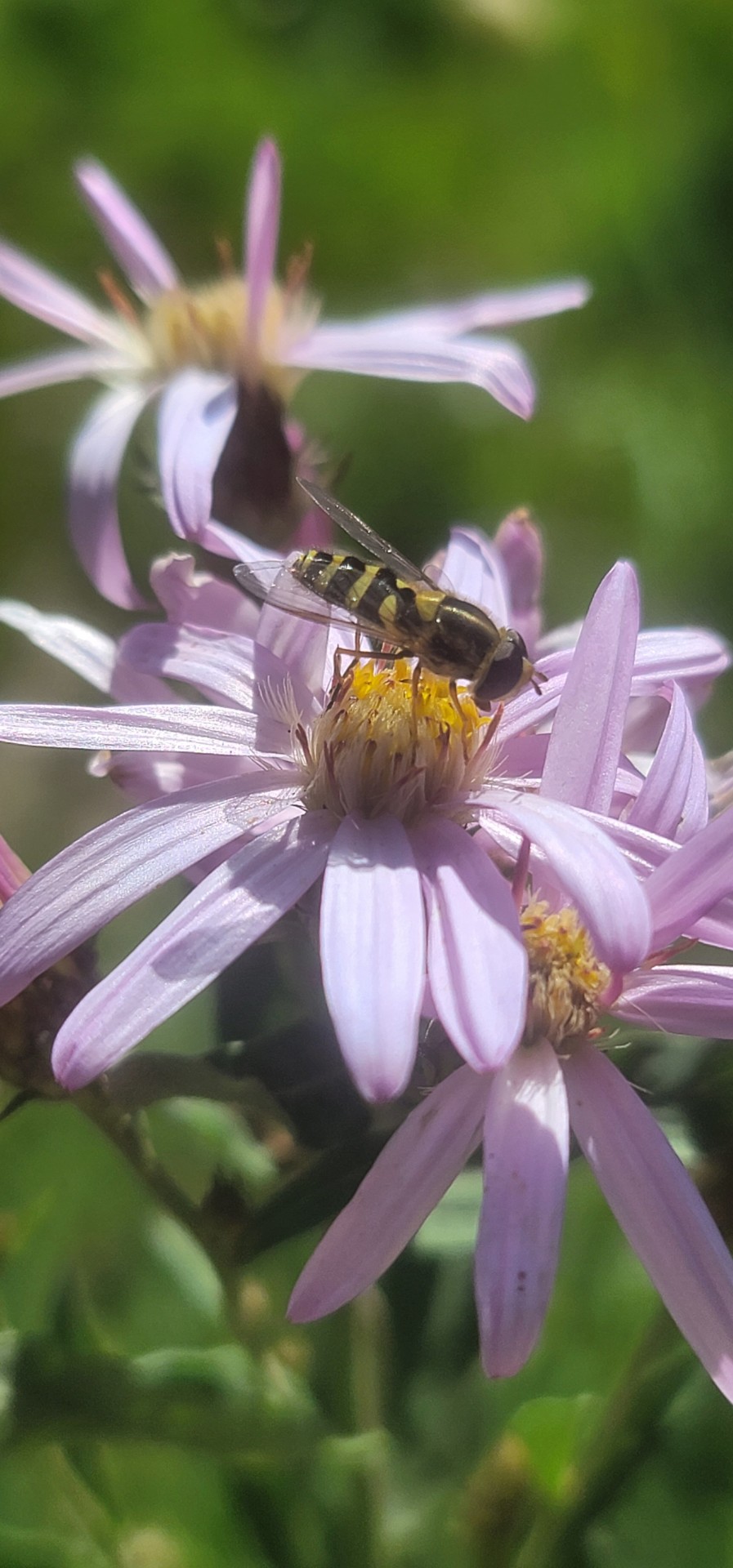
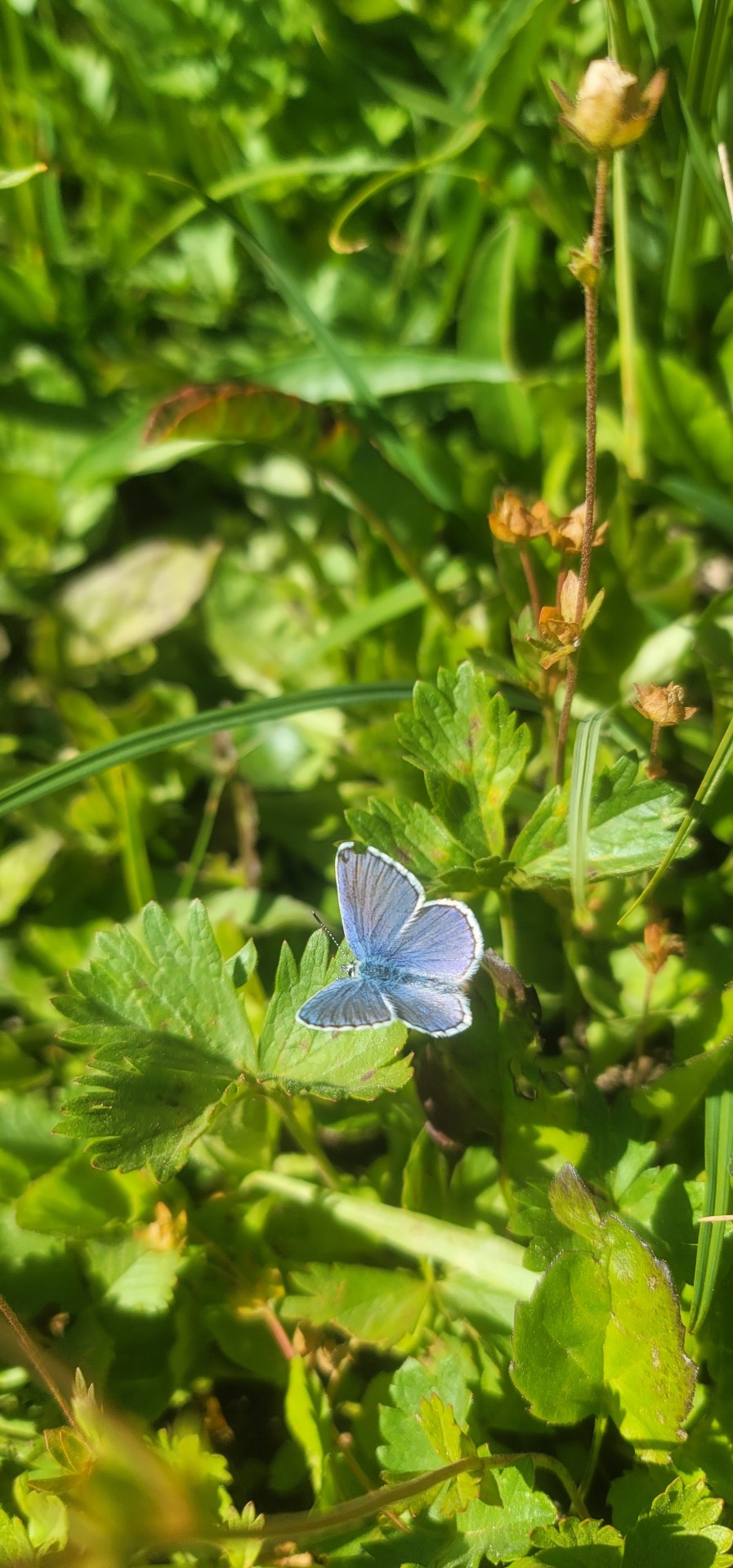
7/29/2023
Mount Rainer
1. Long horned Beetle (evodinus monticola)
2. Bee mimicking flower fly (sericomyis chalcopyga)
3. Gossamer-winged butterfly - Boisduval's Blue (plebejus icarioides)
#mine#insects#flowers#mountain flowers#hoverfly#flower flies#beetles#pnw#pnw insects#Mount Rainier#purple#yellow#green#long horned beetle#gossamer winged butterfly#boisduvals blue#photography
3 notes
·
View notes
Text
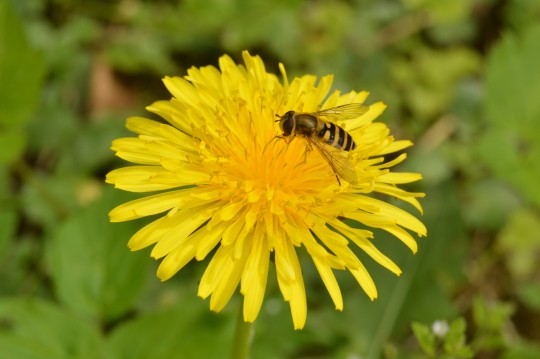

Two types of Diptera
1 note
·
View note
Text
I see at least one cool bug a day, and usually many more, but it’s not because I live anywhere particularly rich in strange, wonderful creatures (I live in an unremarkable corner of Pennsylvania, USA) or spend all of my free time looking for bugs (well, just *most* of it). in my experience, finding interesting bugs is less about actually locating them and more about looking closely at tiny things you’d otherwise ignore!
this very long post was compiled over a couple days in late July, although I spent less than 10 minutes at a time searching. there’s a lot of fun creatures just out in the open.

plants are always a good place to start when looking for bugs, and I chose this small fig tree (Ficus carica) with a mulberry sapling friend. feeding on the sap of the fig and mulberry is the first group I’ll take a look at, the planthoppers:

these two are flatid bugs, Metcalfa pruinosa and Flatormenis proxima. flatids are slow-moving bugs that can be approached closely, but once they get tired of circling around stems to avoid you they may launch themselves into a fluttering flight with spring-loaded rear legs.
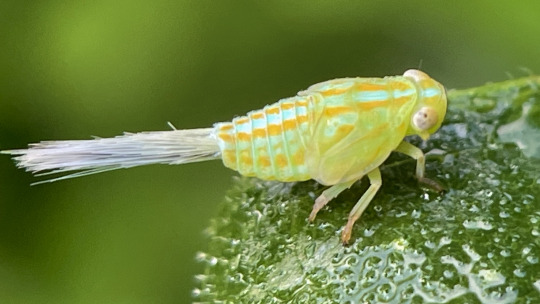
Aplos simplex, a member of the related family Issidae, also likes fig sap. its “tail” is actually a tuft of waxy secretions, which get shed along with the bright colors when it assumes a lumpy, bean-shaped adult form.
cicadellids, or leafhoppers, are just about everywhere on plants, but can be hard to approach without scaring them.
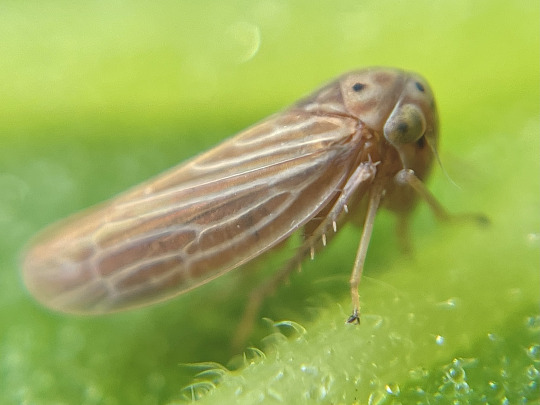

Agallia constricta on the left is a tiny species that feeds on grass, but many were scared up onto the fig by my footsteps. Jikradia olitoria is a much larger species that does feed on the fig; juveniles like this are curled, creeping goblins while adults’ rounded wings give them a pill-shaped appearance.
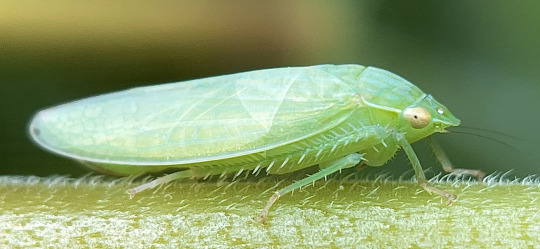
this big, pale leafhopper belongs to genus Gyponana. it’s tricky to get to species ID with these.
Graphocephala are striking little hoppers that eat a variety of native and nonnative plants. G. coccinea is the larger, more boldly colored one and G. versuta is smaller but more common locally. they’ll sit on the tops of leaves but take flight if you get too close quickly.


another group you’re almost guaranteed to encounter are flies (Diptera). these are a very diverse group, so much more than houseflies and mosquitoes (though I did run into both)
where I live, any plant with broad leaves is almost guaranteed to have a few Condylostylus, long-legged flies that come in shades of blue, green, and red. despite their dainty physique, they’re agile predators, typically feeding on other small flies.
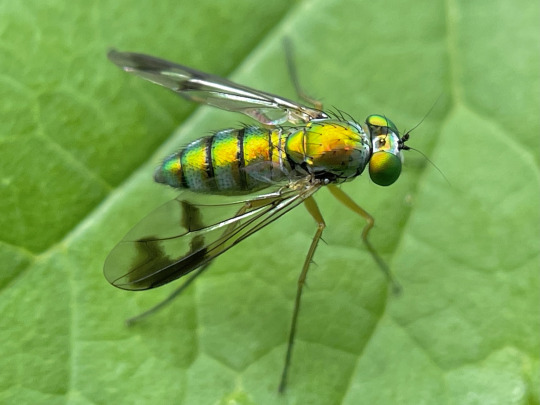
next, a few hoverflies: the ubiquitous Toxomerus geminatus and a Eumerus that I’ve been seeing a lot of this year (but maybe I’ve just noticed them for the first time). syrphids have varied life histories, but most adults drink nectar and many of the larvae are predaceous on aphids.
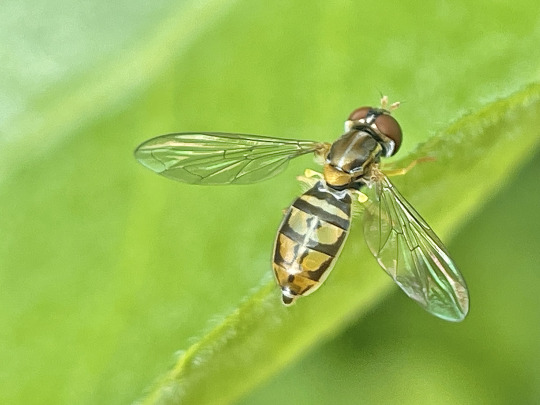

the metallic green soldier fly is Microchrysa flaviventris, nonnative here. Coenosia is a fun example of a “fly that looks like a fly,” with big red eyes and a gray body, and you might think they’re just another dung-sucking pest, but they’re actually aggressive predators! this one seemed to have nabbed itself some sort of nematoceran fly, maybe a fungus gnat.
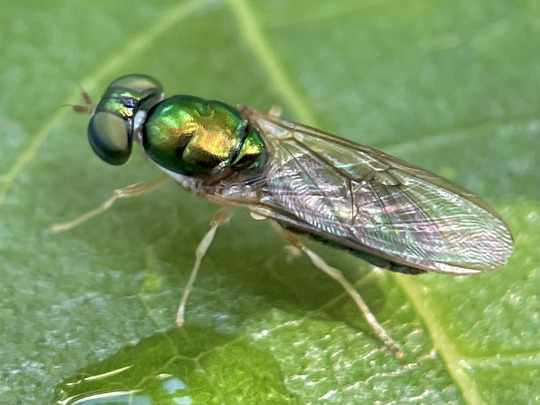

many flies are very tiny, just millimeters long. the first two little fellows are lauxaniids, while the last one, an agromyzid leafminer Cerodontha dorsalis, burrows through grass leaves as a larva.
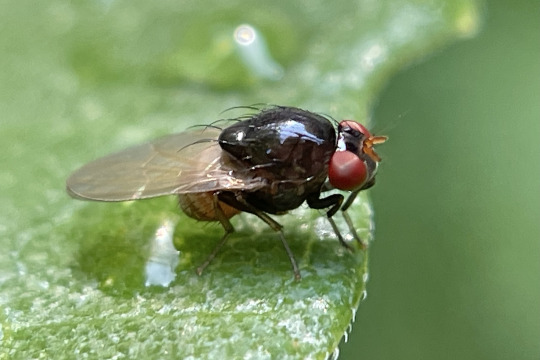
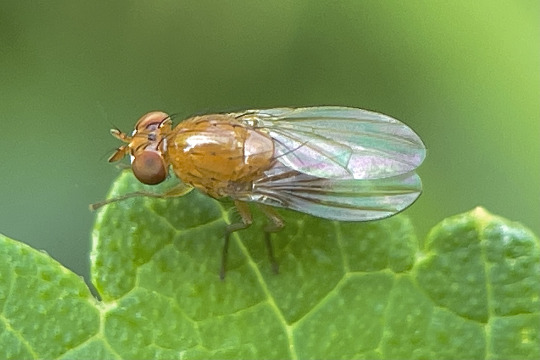

while moths and butterflies (Lepidoptera) are drawn to plants for their flowers or to lay eggs, many small moths can easily be found resting on or under leaves during the day.
these first two are tortricids, many of which are flat, rectangular moths resembling chips of bark or dead leaves. the apple bud moth, Platynota idaeusalis, feeds on a wide variety of hosts, while this beat-up old Argyrotaenia pinatubana would have developed in an edible tube nest of pine needles.


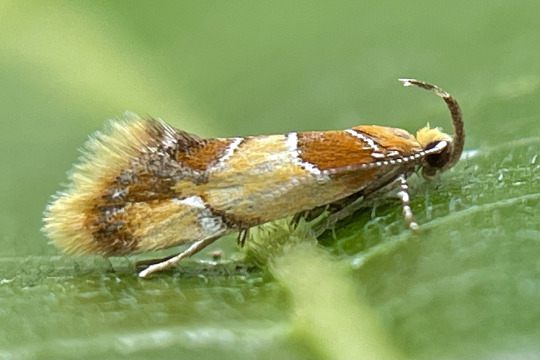
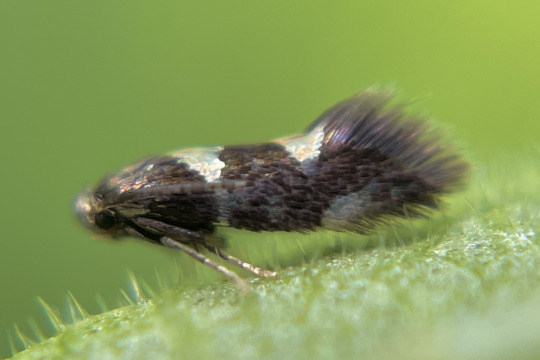
Callima argenticinctella feeds in bark and dead wood (a resource used by more caterpillars than you’d realize!) while the last moth, possibly an Aspilanta, is a leafminer.
although beetles (Coleoptera) are famous for their diversity, I didn’t find too many on the fig. the invasive Oriental beetle Exomala orientalis resting here can be found in a wide range of colors, from this common tan to to deep iridescent black. the other beetle is a Photinus pyralis firefly, sleeping under leaves as fireflies do.
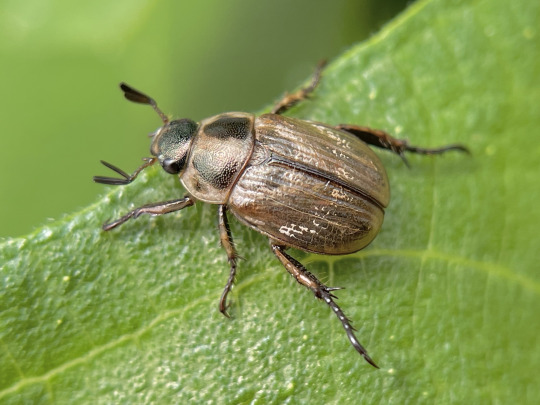
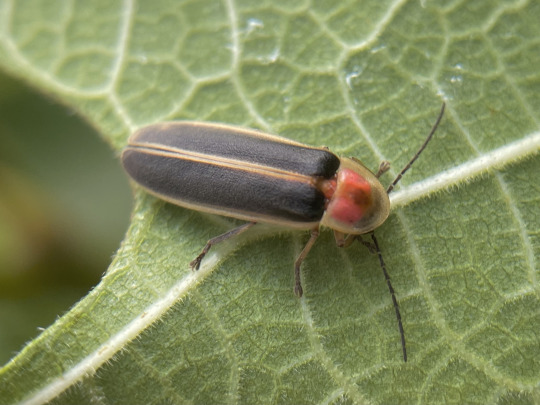
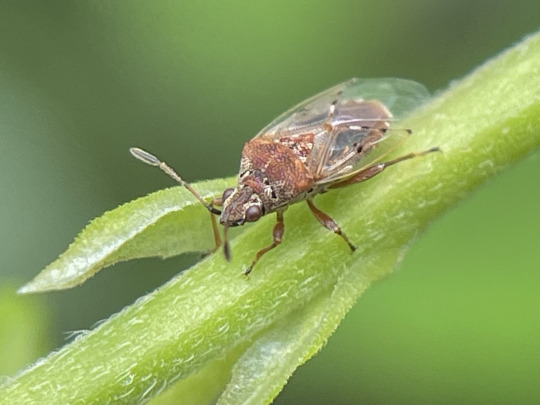
a few spare hemipterans: a Kleidocerys resedae that blew in on a wind, and below, the mulberry whitefly Tetraleurodes mori feeds on its namesake host. as for Hymenoptera, I saw manny tiny parasitic braconid wasps and various ants attracted to the planthoppers’ honeydew excretions—always worth checking underneath roosting hoppers for things having a drink.

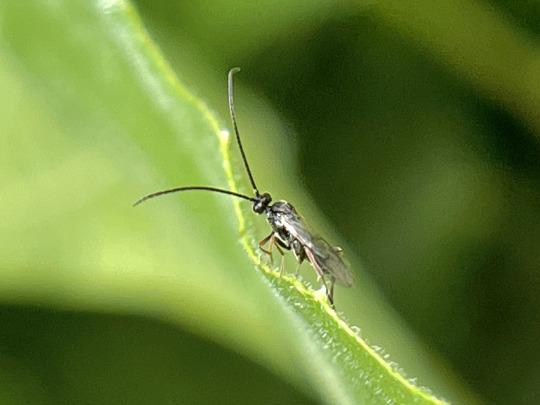
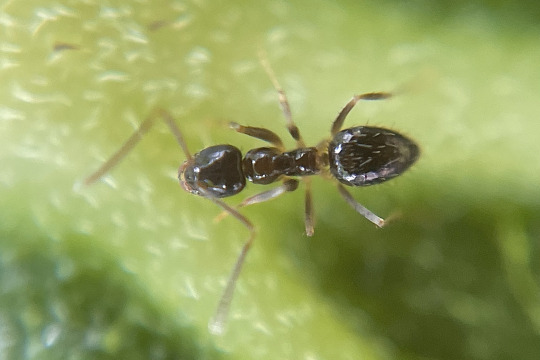
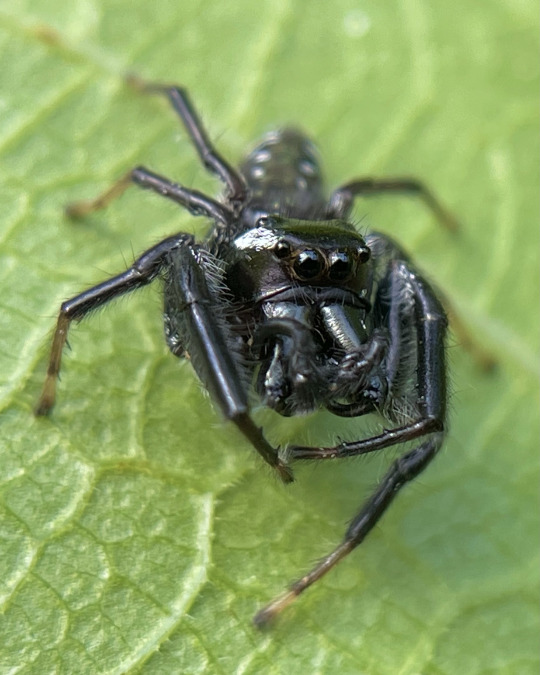
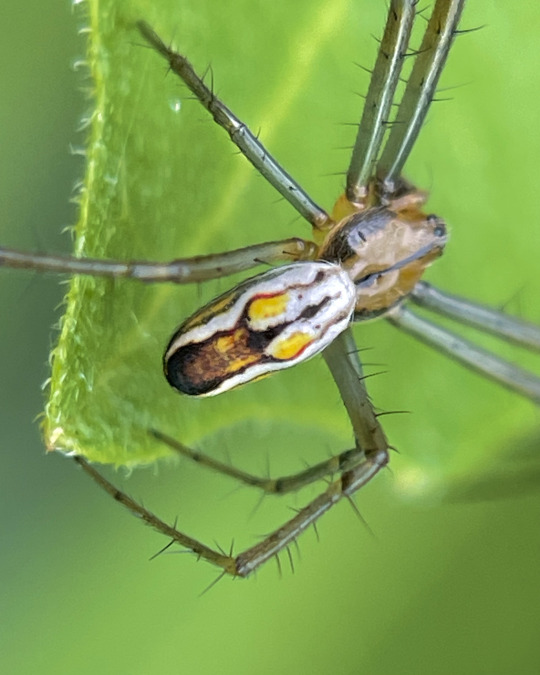
a couple handsome spider boys were scrambling through the fig seeking females, a jumping spider Paraphidippus aurantius and an orbweaver, Mecynogea lemniscata.
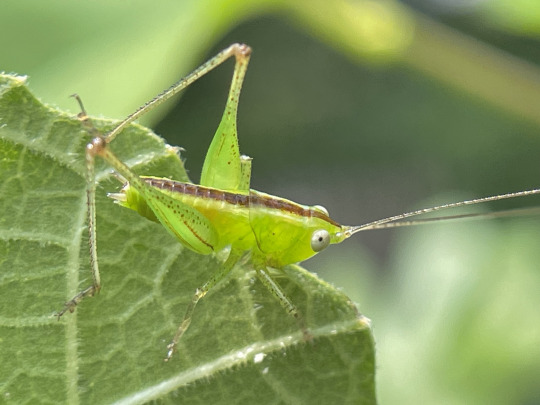
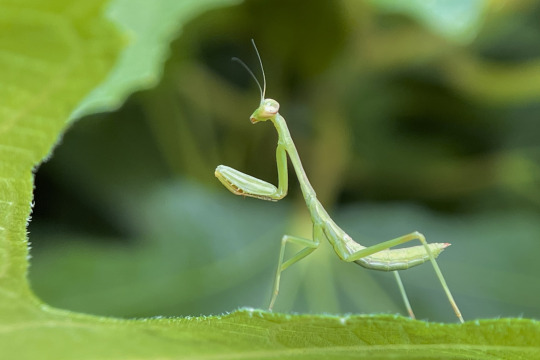
and to round it off, a young Conocephalus meadow katydid and a Carolina mantis, Stagmomantis carolina.
there’s 31 species of arthropod in this post, and I probably saw some 45, not all of which stayed for photos. if you walk slowly and look closely, you can see a sizeable chunk of your local biodiversity in under fifteen minutes! of course this will depend on where you live and what time of year it is, but there’s almost always more cool bugs out there than you’d expect, even on just a single plant.
1K notes
·
View notes
Text










Marginated Calligrapher Hoverfly - Toxomerus marginatus
The long task of untangling bishop's weed roots from the roots of rambling roses continues. However, many of the roses in the yard had started to bloom since the previous set of yardwork images. Their blossoming colors and tantalizing aromas have brought many nectar-hungry pollinators to the yard, including today's striped specimens. When initially stepping out into the yard, I found the individual in Picture 6 hovering around the larger plant blades and was able to take one picture thinking that would be the end of it. How wrong I was! There were so many more small Hoverflies gathering, coming and going among the yard's court of roses (no thorns) here. They can simply tuck in atop or underneath the anther filaments to mop up pollen and any pooled nectar available. Moreso the latter as roses tend to be more of a pollen-rich flower, which nevertheless makes them quite important to insects, especially Bees...and Flies that can pretend to be Bees thanks to their patterning and appearance. When observing these little pollinators, I was curious to see if it was just one specie of Hoverfly coming to these flowers or many species.
In previous years, I've found other types of Calligrapher Hoverflies in this area, including the Eastern Calligrapher Hoverfly and other similar genera. The two calligrapher species can appear similar to each other whether found in midflight or when landed, but they can be differentiated by carefully examining the abdomen and the rearmost part of the thorax. As mentioned in an earlier post, most professionals first look at the margins of abdomen to confirm for this particular Fly genus, so look there also if you can, but you may wind up needing a live specimen or close-ups of your flower-loving insect to do so. Alas, the day of photography only drew in Marginated Calligraphers, making identification easy. It's quite a party inside the roses, and while the camera is able to capture them at a reasonable size, I had to include Picture 5 for sense of scale. How tiny they are! Not only do these roses serve as sources of food for these small pollinators, but also as potential platforms to find mates. For the observer, this also presents an opportunity to find male and female Flies. Try and see which individuals you can find in these pictures. Remembers, in males the eyes touch, and in females, the abdomen tends to have a sharper tip.
Pictures were taken on June 7, 2025 with a Google Pixel 8a.
#jonny’s insect catalogue#ontario insect#fly#marginated calligrapher#marginated calligrapher hoverfly#hoverfly#diptera#insect#toronto#june2025#2025#entomology#nature#invertebrates#arthropods#photography#animals
30 notes
·
View notes
Text
Melixie

Image © Paizo Publishing, presumably, accessed here
[The melixie is in the Bestiary 3, but doesn't have art in that source, being one of three monsters in a two-page spread. @abominationimperatrix found this art for me on a Ukranian Pathfinder blog, and it's definitely PF house style, which makes me wonder if it was posted by the artist somewhere. Anyway, melixies are cute and fun, and I would love to use them in a low level game sometime]
Melixie CR ½ CN Fey This tiny humanoid has the features of a bee—antennae, solid colored eyes without pupils, and chitin over its arms and legs. They buzz about on two pairs of translucent wings.
Melixies are fey creatures with the features of pollinating insects. Bees are the most common, but melixies resembling butterflies, moths, hoverflies and even beetles or thrips are not unheard of. They have an insatiable sweet tooth, and their diet is predominately sugar based. If a melixie can resist consuming their raw ingredients, they can use them to make tiny candies, baked goods and other deserts. Melixie confectionary is famous for both its variety and quality, and some discerning gourmets keep a melixie chef on hand for making treats that both taste great and are less filling.
Melixies believe in working hard, playing hard, and resting hard. They are willing to do even repetitive labor that other fey scoff at, as long as they are properly provisioned with sweets. Consuming a large portion (for their tiny bodies) grants them a burst of energy, allowing them to move exceptionally fast for a brief period before needing to rest and recover. Melixies often use this ability if they are in combat, letting them make hit and run attacks with their acid splashes and stingers (all melixies have a short retractable sting, regardless of the specific insect they resemble). Melixies get along well with arthropods of all kinds. Many melixies raise both regular bees for their honey and giant bees as guard dogs.
Melixie CR ½ XP 200 CN Tiny fey Init +4; Senses low-light vision, Perception +5
Defense AC 16, touch 16, flat-footed 12 (+2 size, +4 Dex) hp 11 (2d6+4) Fort +2, Ref +7, Will +3 DR 2/cold iron
Offense Speed 10 ft., fly 40 ft. (good) Melee sting +7 (1d6-1) Space 2 ½ ft.; Reach 0 ft. Spell-like Abilities CL 2nd, concentration +5 Constant—speak with arthropods At will—acid spray, dancing lights, ghost sound (DC 14) 1/day—ant haul
Statistics Str 9, Dex 19, Con 15, Int 14, Wis 10, Cha 16 Base Atk +1; CMB +3; CMD 12 Feats Weapon Finesse Skills Acrobatics +9 (-3 to jumping), Craft (confectionary) +7, Diplomacy +8, Escape Artist +9, Fly +17, Perception +5, Profession (beekeeping) +5, Stealth +17; Racial Modifiers +4 Craft (confectionary) Languages Common, Sylvan, speak with arthropods SQ sugar rush
Ecology Environment warm and temperate land Organization solitary, pair or hive (3-24) Treasure standard
Special Abilities Speak with Arthropods (Sp) This functions as speak with animals, only it can be used to communicate with vermin that are arthropods, such as spiders, insects, centipedes or crustaceans. This is the equivalent of a 1st level spell. Sugar Rush (Su) As a move action, a melixie can consume a large quantity of sugar, honey or other sweet substance (at least ½ a pound). When it does so, it can take an additional move action for the next 1d4+1 rounds. When this time elapses, the melixie is fatigued for 1 minute. A melixie cannot use its sugar rush ability when fatigued or exhausted.
66 notes
·
View notes
Note
If Killer ever decided to make Horror and Dust meet Nightmare or maybe even Nightlight, what would the first interaction dialogues with them be like? Would Nightmare be able to perhaps recognize the pair of summer and winter fairies from small quips by Error or even Dream? Or are they completely unfamiliar?
“This is Dusty, or Dust, but that’s boring so I like calling him wittle dusty bunny boo,” said Killer, giggling even as the petite fairy cast him an unimpressed glance. “And this Horror, or Hot Stuff, as I like to call him,” Killer continued, and grinned as he held around the winter fairy’s abdomen as best as he could and nuzzled his face against Horror’s bosom, purring up a storm even as Dust began to glare at him. Horror flushed prettily and only lightly petted Killer’s head in response, but still he was unable to keep his eye off Nightmare’s form.
The Autumn Queen sat upon his throne, regal and beautiful as a long, draping dress spun with morning dew and glitter of frost clung gently to his form. With one elegant leg crossing over the other he observed the trio closely, from Killer’s foolish faerling speech, to Dust’s quiet staring, and over to Horror’s towering but soft frame; the latter appeared shy in his presence and looked away as their eye lights met. They both only had one to look upon each other, and Nightmare let the ghost of a smile grace his lips.
“Leave them be, Killer, I want my guests to be comfortable while they visit my realm,” said Nightmare, and still he watched as his loyal guard stepped aside, though not without a small pout to his face. Adorable, as always. “A summer fairy of Dream’s own desires, and a winter fairy of Error’s own strength, yet grown apart from their respective homes,” said he, and his eye wandered over them. Dust finally looked away, a light flush of colour dusting his pretty cheeks. “Many would view it as a tragedy to be scorn by their own familiar fairies, yet you two seem content in your own company,” he said.
“… It’s…” began Horror but shrunk a little as Nightmare’s full attention turned to him.
“Go on,” said Nightmare, tone gentle.
“It’s better that way,” said Horror, slowly finding his voice despite both his awed and intimidated state. It was so difficult to not admire the autumn queen, and he couldn’t help but cast shy glances even if that bright eye light looked directly at him. “We like it alone. We…” he cast a glance at the petite fairy by his side, who subtly moved closer, and he felt stronger as Dust’s small hand came to hold his own; supportive. “We are happy together. We don’t need anyone else,” he said.
“And what of my loyal guard?” asked Nightmare. “What is he to you?”
“A new friend,” answered Horror, and looked at Killer with a wide, but kind smile. “A silly, but good friend,” he said. Killer audibly cooed but was commanded to stop his advances before he could attack Horror with affection.
“A nuisance, like a hoverfly that’s too curious,” said Dust, and Killer feigned dramatics even as all eye lights turned to him. He hid within his scarf as he blushed. “But I like him,” he murmured.
“I knew it!” Exclaimed Killer and thrust himself up into the air, fluttering wildly in circles before landing by Nightmare’s throne. “I told you he liked me,” he said, and purred much like an obedient pet as Nightmare lazily stroked his cheek with the back of his fingers.
“Good,” hummed Nightmare, and smiled; pleased. “Very good.”
#aufairyverse#utmv#ask for the fairy#fairy!nightmare#nightmare sans#fairy!killer#killer sans#fairy!horror#horror sans#fairy!dust#dust sans#canon
77 notes
·
View notes
Text
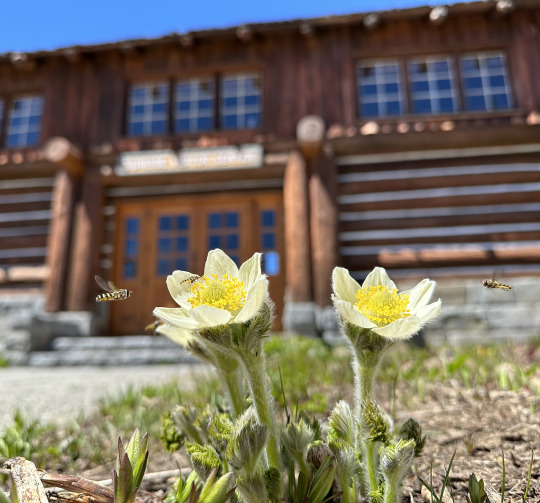
While there is still patchy snow, early season wildflowers are also emerging in subalpine areas like Sunrise! These pasqueflowers were found blooming in front of the Sunrise Visitor Center with hoverflies already hard at work as pollinators. Pasqueflowers (Anemone occidentalis) have big blooms with white petal-like sepals and yellow stamens. The entire plant is covered in long shining hairs that help insulate it from cold and windy subalpine conditions. Later in the season, the blooms are replaced by large mop-like, feathery seedheads, sometimes called “mouse-on-a-stick”. What early wildflowers are you observing in the park?
Please remember to stay on trails to protect the delicate subalpine wildflowers just starting to grow, even if it means crossing patches of snow!
For updates on what’s blooming where visit https://go.nps.gov/RainierWildflower
Unfamiliar with Mount Rainier’s wildflower species? Check out the wildflower guide at https://go.nps.gov/RainierWildflowerGuide
NPS Photo of pasqueflower blooming at Sunrise, 7/3/24.
34 notes
·
View notes
Text
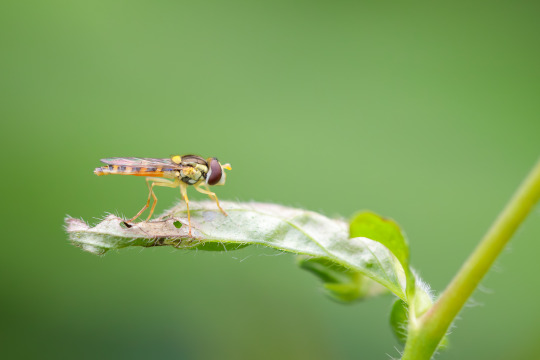
Long Hoverfly
A female long hoverfly sitting on a leaf, in the garden.
#30dayswild#canon#canonuk#Denoise#fauna#garden#hoverflies#hoverfly#insect#insects#invertebrate#invertebrates#long hoverfly#minibeast#minibeasts#nature#outdoors#sphaerophoria scripta#summer#wildlife
2 notes
·
View notes
Text



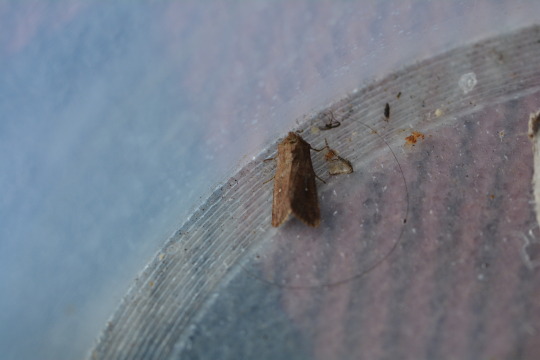
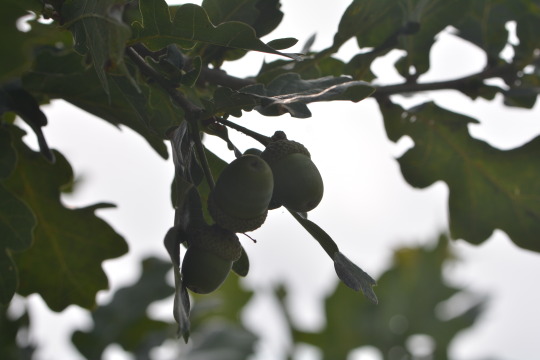
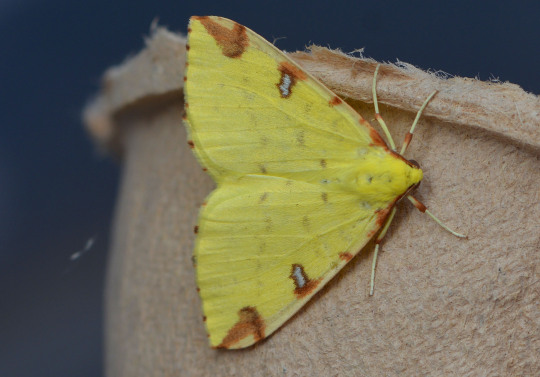

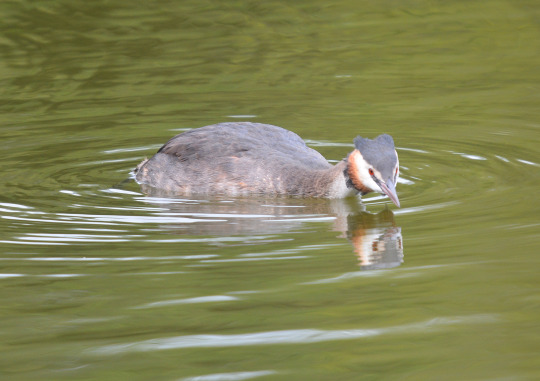


29/08/2023-Lakeside and home
Photos taken in this set: 1. A nice moth that came into a moth trap we did last night. 2. Yarrow out the front. 3. Mugwort on my Lakeside lunch time walk. 4. White-point moth. 5. Acorns on my way to Lakeside, I enjoyed seeing these at Lakeside too on a day I enjoyed oak. 6. A beautiful and dazzling Brimstone moth, we had more than one in the trap a distinctive moth I had enjoyed seeing before this was my first home sighting. I was pleased to see this one. 7. A gorgeous Shuttle-shaped Dart, a fascinating new moth for me. Seeing this alongside a few other new ones and firsts for the year made my moth year list my highest ever, the fourth of my five year lists I've reached this point with this year with the other (my dragonfly and damselfly year list) being my joint highest ever total which I am thrilled with. 8. An adult Great Crested Grebe at Lakeside, I enjoyed great intimate views of it and its calling chick which was a key moment on the walk with others seen. 9. Dogwood, great to see flowering and berries I do enjoy this in the late summer/autumn. 10. View on a lovely lunch time walk.
Other moths seen from the trap were Vine's Rustic again after last night, my first ever Lesser Yellow Underwing and Pale Mottled Willow, Large Yellow Underwing, a stunning Willow Beauty and my first Square-spot Rustics of the year I do love these. A fun activity that we've not done before doing a trap and I think we'll do more. Some fine views of Small White and Speckled Wood were highlights at Lakeside, with Common Darter and a pretty Long Hoverfly seen too. I was fixated on a cheery flock of Long-tailed Tits with Chiffchaff and Great Tit mixed in whilst in the southern fenced off area, with Blue Tit possibly seen too and heard in the garden today. Blackbird, Carrion Crow, Magpie, Woodpigeon, Moorhen adult and young, Mallard and great views of Lesser Black-backed Gull and soothing Wren heard feeling springlike funnily enough as I heard it for a minute were other Lakeside highlights. Cress and dock out the front, giant broad-leaved clovers at Lakeside, knapweed, thistle, ragwort carpeting the place nicely, fleabane, bird's-foot trefoil, lady's bedstraw, my first self-heal for a little while, water mint, great willowherb, purple loosestrife, yarrow, a wealth of rose hips and hawthorn berries were great flowers seen at lunch time. Collared Dove, House Sparrow, Jackdaw, the immersive sight and fluent calls of Starlings and snails on the balcony were good from home sightings today.
#photography#moths#shuttle-shaped dart#the white point#great crested grebe#blackbird#carrion crow#moorhen#common darter#small white#speckled wood#long hoverfly#uk#world#home#lakeside#lakeside country park#nature#2023#europe#birds#birdwatching#photos
2 notes
·
View notes
Note
Feeling very sidekick/Dekiru agency brained right now so:
-If Izuku still had OFA in Bad Miracles (and also if it wasn’t a death sentence for people with Quirks to inherit it) which one of the sidekicks would be most likely to be his successor?
-Who’re all the sidekicks favorite heroes?
-What does Yuki-onna do when she’s not on duty?
-Besides being an absolute media terror, what’re Party Animal’s biggest assets to the team?
Oh boy a multi parter!
1: He wouldn't give OFA to any of them. He loves his sidekicks. He does. He's put a lot of effort into his current team and they're a well oiled machine he has a lot of pride in. But would be trust them with godlike power? No. Absolutely not. Yuki-onna might seem like a rational and trustworthy person but she regularly allows bullshit to happen for her own amusement.
Party Animal? Cannot be trusted period with it because he lacks long term planning skills and needs constant direction.
Hoverfly? He's 17 medical conditions in a trenchcoat and would explode.
Skarecrow? He would also explode, but because the pressure is too much.
(That's not to say Deku doesn't find a successor, quirk or no quirk. We just don't get to meet her for a good, long while. This initial fic isn't the only thing I've thought of for the Bad Miracle universe.)
2: Yuki-onna: Ryukyu was a big inspiration to Yuri growing up, but she has an extreme fondness for Underground heroes. She isn't sure she can hack it herself on the Underground scene but the Dekiru Agency is a Twilight Agency, so she gets to help them out a lot and it's really fulfilling.
Skarecrow: Batman. Is he a real hero? No. But he's Damian's favorite. America worships at the altar of Batman and Damian is no exception to this. You can pry the Bat from his cold, dead hands.
Party Animal: As a wolf heteromorphic mutant himself, Kouhei is a big fan of his fellow big animal guys. Gang Orca and Hound Dog and Shishido and the like. He looked up to them a lot as a kid who wasn't allowed to ever let his mutation show in public
Hoverfly: His older brother. He's now a hero called Earthshaker down in Okinawa, and Shinji continues to be his #1 fan. Nobody else likes this because, in Deku's own words, "He's fucknuts crazy."
3: Yukimoto Yuri is actually a massive trad goth when not on the clock. We will see this in the next chapter. Deku is actually super envious of her ability to separate her personal and work life, because Yuki-onna's entire fanbase is absolutely rabid for the traditional beauty in a battle kimono who looks like she studies tea ceremony.
And then the second her shift is done she looks like this


It's black magic is what it is. How does she do her makeup so fast. How in the hell does she fit her platform shoes in her work locker. The world may never know.
4: Okay. So. Ookami Kouhei from the outside looks like the weakest link in the Dekiru Agency lineup. A deadly ice queen, one of the worlds greatest experts on blood quirks from one of the most powerful hero families, and one of the strongest telekinetics in Japan--and then what. A big dog? A big dog who can barely remember his own phone number?
The thing is.
You know how Deku has insane amounts of stamina? A guy who obliterates his own bones and keeps on going when anyone else would have passed out screaming and coughing up blood? Even now without a quirk, he's still plowing through things like he's the Terminator and it's terrifying.
Party Animal's quirk is this: the more adrenaline and/or dopamine he has rushing through him, the more he changes. The more he mutates and becomes a bigger, stronger wolf man.
The stronger he gets.
The more durable he gets.
Party Animal is the only sidekick in the entire agency that can not only keep up with Deku, but outlast him and keep fighting.
Party Animal is a human wrecking ball who only gets more powerful the longer a fight drags on, and when Deku laid eyes upon him for the first time he knew this was the ultimate asset to keep in his back pocket, extremely rich and pissed off parents be damned.
9 notes
·
View notes
Text
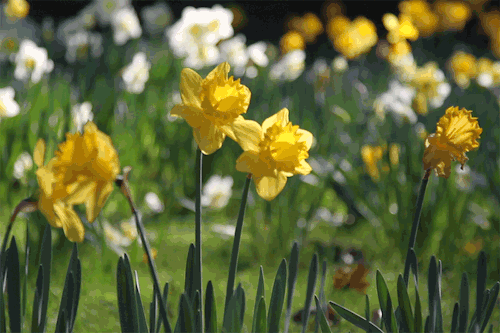
----------------------------------------------------------------------- Participated in a danganronpa gift exchange (I don't have the @ for it, but it's Island Mode - Freetime Events) for @quasiimodo Hope you enjoy!
-Mod Tsumugi
----------------------------------------------------------------------
Freetime Event: Planting Flowers The golden sun shone brightly in the cerulean sky above Hope’s Peak Academy, the intimidating building’s spires casting long shadows across the meticulously trimmed hedges and pristine pathways connecting all parts of the school grounds. The school was divided up based on student speciality, with the sun beating especially hard down on the raised gardens frequented and tended to by Ultimate Florists, Gardeners, Farmers, and other students looking to appreciate some beautiful nature. Among those tending to the garden beds today, was Shuichi Saihara, the Ultimate Detective, kneeling on the pebble pathway beside one of the plots. He adjusted his dark-colored hat on his head, blocking out the sun’s rays as best as he could.
Also serving to block out the sun for Shuichi, was the Ultimate Entomologist, Gonta Gokuhara, who towered over the plot of dirt like a gentle giant, carrying a tray of budding seedlings in his large, calloused hands. “Thank you for helping, Shuichi,” Gonta said, his voice tinged with earnest gratitude. “Gonta wants to make garden beautiful and helpful for bugs, but Gonta not so good with planning part.” Shuichi offered him a small smile, brushing a smudge of dirt from the heavy-duty gardening gloves he had on.
“It’s no problem, Gonta. This is a great idea. A garden like this will attract pollinators and keep everything here healthy. Plus, it’s definitely relaxing.”
Gonta beamed, his enthusiasm as infectious as ever.
“Gonta happy to hear that! Bugs will love these flowers! And maybe classmates will enjoy them too.”
The pair had spent the better part of last week discussing which plants to add to the gardens, pouring over countless gardening guides, almanacs, and insect reference books for ideas. Gonta had eagerly suggested flowers he knew were popular with “good bugs” - the ones that helped plants grow and kept pest levels down. Shuichi had taken careful notes in a small, brown notepad, one that was now open on the ground between the two of them.
“Okay,” Shuichi began, consulting his well-written notes, characterized by pencil lead smudges and eraser marks. “Let’s start with the bee balm. It’ll attract pollinators and keep mosquitoes away, which I’m sure the others will appreciate.”
Gonta nodded, setting down the tray of vibrant, multi-colored bee balm flowers, their spindly petals fanning out and flowing with the wind. Grabbing a trowel, he dug into the dirt, before gently placing the intact roots inside and patting it down.
“Bee balm smell nice too. Bees and butterflies will be so happy!”
“Next are the zinnias,” Shuichi said, glancing over at the fluffy, pastel flowers balanced on the tray. “They’re great for butterflies, parasitic wasps, and hoverflies. I think they’d look good in the middle, right?”
As Gonta dug into the dirt, the earthy smell mixed in the air with the soft floral notes. Shuichi picked up a few of the small flowers, lowering them into the holes that Gonta had prepared, before patting them down.
“They so colorful, like little suns and rainbows!”
Gonta hummed softly, his gentle hands lightly packing down the soil so to not hurt the delicate roots. Shuichi founds himself relaxing as they worked side by side, the routing motion of digging and planting soothing his usually overactive mind.
“Now for the dill, the feathery ones. They should be good for ladybugs and lacewings, and it’ll keep aphids away.”
Gonta tilted his head thoughtfully.
“Ladybugs are so helpful. And so cute! Gonta hope many ladybugs come to visit.”
The two of them planted the dill in neat clusters, ensuring there was enough space for each one to grow bigger. The sun climbed higher in the sky, warming their backs as they worked. A few birds chirped from a nearby tree, a melody only nature could provide. As they planted more and more, alyssum and marigolds, the plot began to resemble a kaleidoscopic mosaic of colors and textures, each one carefully placed almost in a pattern. Gonta wiped his brow, leaving a streak of dirt on his face, but his grin was about as radiant as the garden.
“Shuichi, thank you for helping Gonta. This garden will make bugs happy, and that makes Gonta happy too.” Shuichi glanced at the flourishing garden, feeling a quiet sense of accomplishment.
“You did most of the work, Gonta. I’m just glad I could help. I think everyone’s going to like the garden.”
As they gathered their tools and began to tidy up, a honeybee buzzed past, landing delicately on one of the newly planted bee balm flowers. Gonta’s eyes widened in delight, lighting up at the sight.
“Look, Shuichi! First visitor!”
Shuichi chuckled softly, watching the bee flit from flower to flower.
“I think the bugs already love it, Gonta.”
Together, they stood in the warm sunlight, basking in the quiet joy of their shared accomplishment and the promise of a garden teeming with life.
7 notes
·
View notes
Text
i miss bugs so bad. its mid april and there's hardly been a buzz in the air. how long has it been since ive seen a ladybug hobbling on a blade of grass. what about butterflies dancing from flower to flower or hoverflies zipping from bud to bud. my lights are on at night and yet my windows are noticably unharrassed by moths & other nightly bugs. where are millipedes. where are pondskaters. where are the spiders suspended on the sideview mirrors of cars. hell, even regular old flies. bees. wasps. ants. i see so few of them now. this is such a weird thing to see happen in my lifetime. i really miss just seeing bugs around.
#i know this has already been talked about but i still can't believe how prevalent it is#im sure the fact ive moved closer to the city contributes#i grew up in a small town#but even when i go home to visit#nothing#its so quiet#i still see slugs and snails#when it rains#i suppose#they seem to be doing alright#bugblr#bugs#insects#.txt
24 notes
·
View notes